
Wine Culture and Information since 2002 - Volume 22
 Wine Culture and Information since 2002 - Volume 22 |
|
Issue 107, May 2012 |
Contents |
|
|
A Fault is a Fault, Anyway |
|
It happens more and more to taste wines belonging to the so called natural family, a category not well defined yet and the producers themselves have sometimes different opinions about this subject. Many of these wines - and I am saying this with satisfaction and admiration - are of remarkable quality, well made and, last but not the least, without faults. On the other hand, some of them, as far as I can tell, are the majority, have pretty embarrassing faults, so gross that, not more than ten years ago, they would have been rejected by any wine lover. In these cases, it is very hard for me to consider a fault as a quality just because that wine is natural and for this reason it must be considered a product for the élite. In other words, I don't understand the glorification of natural wines by making this productive characteristic the only factor to be considered for the quality of a product: in case it is natural, it is better, no matter what. I am suspecting the so called natural wines represent - as a matter of fact - just another fashion in wine, a trend every expression and every product needs in order to stay alive and to catch attention. Wine is no exception: in the last twenty years we have seen so many fashions, born, grown up, died and, then, buried, forgotten, even denied. I like to point this out once again: it is not a matter of being contrary to natural wines; a genuine wine is however a goal to be favored and supported. I don't however subscribe to a current of thought, not so different from religious crusades supporting an “absolute truth” and that, most of the times, have the deplorable goal of hiding the “real truth”, by telling pathetic lies. I don't like arrogant currents of thought, rigid and deaf, always convinced to be on the right side, even rejecting those methods from which they come from, while not telling or denying their use even in case it is evident. It is too easy and utopian to say a natural wine is the one produced according to nature - and we should remember wine does not exist in nature - when everyone knows the only “natural journey” of grape juice is to become vinegar. The intervention of man is fundamental in order to affect the natural process in order to avoid what nature taught bacteria in order to ensure a chance of survival. This intervention, it is undeniable, is obtained by means of technology, those processes invented by man and which allowed him to better understand what a wine is and how it can be produced by interacting with natural processes. Denying technology and to consider it as the “absolute evil” is pure madness: even natural wines are the result of “technology”. Technology is not either good or bad, indeed, it is its use to make it good or bad. It would be like saying a straight razor is bad only because it is very sharp and can cause serious injuries, when - for the sake of truth - it is the most efficient tool for shaving and respectful for the skin. It is the use one makes of something to make it good or bad. Looking for new marketing opportunities, hopefully creating particular niche market, clearly is the goal of any business in order to ensure both notoriety and profits. There is nothing wrong about this, however when it is transformed into a speculation, as well as even trying to make others believe an evident fault is a quality, I find this to be unfair, even ridiculous. A fault is a fault, anyway, either of natural origin or created by the worst industrial technique, it however is a fault. I cannot accept as a justification a wine has a fault because it is “natural”. That fault - as such - is an undeniable factor detrimental to quality, something that, in any case, shadows the fact it is a “natural” wine, or of any other productive origin or technique. Not even the supposed genuineness makes me see that fault as acceptable: if for genuine wine is to be considered a wine having faults, instead of having an adulterated or industrial wine, I truly prefer having a glass of plain water. My job - lucky me - gives me the privilege of tasting and evaluating wines daily. Among the many, of course, there are wines their producers proudly classify as “natural”, or however produced with wine making and viticultural techniques that, in many cases, are defined as “natural”. Sometimes these wines have rough and embarrassing faults, oxidation affecting smell and taste, evident contamination of brettanomyces, evident faults caused by acetic bacteria and recalling vinegar, evident oxidation and faults giving the wine a not truly attractive appearance. These wines make me remind about those, that with an evident disgust, are defined as wines of the peasant, wines anyone would not ever wish to have in a glass. Some natural wines remind me about those kind of wines: not truly well made, faults making them ordinary and rough, not pleasing at all, from appearance to taste. I once also tasted a wine with an evident smell caused by an excess of sulfur dioxide. When I told the producer about it, the answer was quite bizarre: if you add just a little of sulfur dioxide, the wine gets oxidized and it can easily be affected by faults. This is not so different from syncretism applied to religions and philosophies: you simply take or reject what, in that specific moment, is better for you. Maybe it is because in wine - this is undeniable - there has been, and continues to be, a boring homologation of organoleptic qualities, result of research and wine making progress which allowed everyone to take advantage of technology and knowledge. I have no problem in admitting sometimes these technological mean are pretty cumbersome and hide, or eliminate, many typical qualities of grapes and of territories. I however have problems in accepting a fault as the expression of a grape or a territory. A fault, in my humble opinion, is simply the expression of the incapacity and inexperience of the one who made that wine, natural or industrial, it makes no difference. In case this must be seen as a quality, even worse, the revealed truth to a small group of wine lovers who - lucky them - are convinced to be the only ones who understood everything in wine, elected apostles of the benevolent Bacchus and repository of the absolute truth, this makes me smile. Let's clear this, once again: a genuine wine, expression of a territory and of its grapes, respectful for the health and wellness of consumers, is a noble and highly wished presupposition. It however does not change the fact a fault is a fault, anyway. Natural or industrial, it however is a fault. Antonello Biancalana
|
||||
Tannins in TastingTannins - better defined as polyphenols - are substances generally associated to red wines, indeed they are also found in other types of wines and play an important role in taste |
|
Tannins, chemically defined as polyphenolic compounds, are substances generally found in vegetables, in particular, in woody ones. These substances play a role of primary importance in wine making, not only during the production of wine, but also - and in particular - in sensorial tasting. Tannins are fundamental elements for the balance in red wines and, they too, need to be properly balanced by other substances in order to get a harmonic taste. Tannins are in fact the main elements responsible for the tactile gustatory sensation of astringency, a quality which is variable for intensity and character according to the type of grape and, in particular, the type of vinification. Although they are generally associated to red wines, tannins are also found, in quite lower quantity, in other types of wine, contributing to the formation of their gustatory balance and their structure. Tannins do not contribute to the taste of wine only. In red wines, and marginally in white wines, when present, polyphenolic substances significantly contribute to the formation of color. As for grapes, tannins are mainly found in the skin, in the peeps and stalk, the latter rarely used for the production of wine. According to the principle of modern and quality wine making, the grape is in fact destemmed before being crushes, that is the berries are mechanically separated from the stalk. Tannins contained in the stalk generally give the wine a strong astringent taste and most of the times they make difficult reaching a good balance. Moreover, astringency of tannins contained in the stalk, has a strong “sharp” and “harsh” nature, different from the rounder and softer astringency of tannins found in grape skins and those extracted from the wood of casks. In rare cases, in particular in grapes with a low quantity of tannins, producers decide to ferment the must with part of stalks, in order to increase the quantity of tannins in wine. In order to get the same effect, sometimes are added grape peeps too, a practice which is also used for the production of particular white wines. In general terms, both the stalk and peeps, are being eliminated from the must before starting fermentation, in order to avoid in the wine the presence of unripe tannins - also called green, with a harsh astringency - while favoring the presence of “rounder” tannins. Roundness of tannins in wine is determined by many factors, not only by the possible contribution of the cask, the wood and its degree of toasting, but also by the type of grape. For example, tannins of Merlot give the wine a different sensation of astringency from Nebbiolo's tannins.
The quantity and quality of tannins found in wine also depend by other factors, including time and their condition at the moment of harvesting. Time is referred to the aging, both done in cask and in bottle, for condition at the moment of harvesting, is referred, in particular, to the evolution. According to a wine making point of view, ripeness of grapes - a condition used for deciding the moment of harvesting - is determined by the so called technological ripeness and, as for red berried grapes, the phenolic ripeness is taken into account as well. Technological ripeness is simply determined by the quantity of sugar and acid contained in the berry and, on this regard, it should be noticed that, as the ripening process goes by, sugar tends to increase while acid substances tends to decrease. Phenolic ripeness is about the evolution of tannins and phenolic substances, an essential condition in order to get softer and less unripe tannins. The work in vineyard - in the cultivation of red berried grapes - therefore requires the control of both ripening processes, while trying to start harvesting at the moment of the best ripeness of tannins and, at the same time, the right balance between sugar and acid substances. The control of both ripening processes in fact ensures grapes with the right balance for wine making purposes, the indispensable condition for the production of alcohol as well as round tannins and not excessively harsh, moreover, a right acidity in order to get a proper balance in wine. Not always it is possible to reach the best condition for both ripening processes, therefore it is essential to mediate both conditions in order not to compromise wine quality. Roundness and quantity of tannins found in a wine will also be affected by the possible fermentation and aging in cask, a factor which is also determined by the type of wood and its degree of toasting. According to a technical point of view, the action and effect of tannins are not only about the sensorial tasting of wine. These chemical compounds play in fact an important role for the keeping of wine, thanks to their antioxidant property. In general terms, wines with a high content of tannins can age in bottle for a long time - we should think, for example, to Nebbiolo, Cabernet Sauvignon and Sagrantino - a possibility which is determined by other factors as well. It is not by chance, for example, that most of wines produced with Nebbiolo grape - among the varieties having the highest content in tannins - such as Barolo and Barbaresco, can age in the bottle for tens of years. In this specific case, it should also be noticed acidity and alcohol typical in these wines significantly contribute to the keeping and the evolution over time. Tannins significantly contribute to the structure of wine, a quality determining body as well as part of balance. The practice of adding tannins to wine - generally extracted from the wood of particular trees or woody plants - is something adopted not only in red wines, but also in white and sweet wines. The adding of tannins, besides increasing wine structure, makes it possible to obtain a better stabilization, as well as a better keeping over time. The adding of tannins - like already said - can also be done by fermenting and aging the wine in barrels. In this specific case, the passage of tannins from the cask to the wine is determined by many factors, including the volume of the cask, the type of wood and the degree of toasting, the number of “passages” done in the cask. For example, the quantity of tannins passed to a wine is generally higher in a barrique than in a 500 hectoliters cask, whereas an old barrel will give a lower quantity of tannins than a new one. According to a sensorial and organoleptic point of view, tannins affect three qualities of wine: appearance, taste and tactile sensations perceived in the mouth. Red wines certainly are the ones mostly affected by the evident coloring action of tannins. The color in this type of wines is in fact determined by particular polyphenolic compounds called anthocyanins or anthocyans, as a matter of fact, belonging to the family of flavonoids. Anthocyanins - from the Greek anthos, flower, and kyŠneos, blue - are water-soluble coloring substances giving a hue ranging from red to blue, according to the chemical characteristics of the liquid in which they get in contact with. The dominant presence of anthocyans having a blue color is generally visible in young red wines that, by getting mixed with red coloring substances, give the wine their typical purple red. With time, tannins found in wine tend to polymerize - that is the molecules bond together therefore increasing their size and weight - causing their precipitation. The first coloring substances to precipitate are the ones having a blue hue, therefore - after many years - red coloring substances. This phenomenon determines the development of color in red wines. Anthocyans of blue color, typical in young wines and giving them the characteristic purple color, are the first ones to precipitate therefore allowing red substances to become more evident, and - after many years - they too precipitate causing the wine to get a brick red color. In white wines, the effect of tannins in color is pretty marginal, however not negligible at all. The skin of white berried varieties does not contain coloring substances in a significant quantity, however the tannins given by the cask during fermentation and aging, contribute to the formation of the color in these wines. It should be noticed, the color in white wines produced in cask is also determined by the oxidizing effect caused by the passage of oxygen through the pores of wood. The polymerization of tannins does not produce effects on wine appearance only. This process - as we will see later - produces evident effects also in taste, in particular in tactile sensations responsible for astringency. According to an organoleptic point of view, tannins do not have a well defined taste, however - in wine - their effect is perceived in the mouth with a basically bitter flavor. The main sensorial effect in taste caused by tannins is of tactile nature, clearly recognizable in astringency. Tannins bond to proteins, substances also found in saliva, therefore producing a sensation of dryness in the oral cavity and therefore producing the effect of astringency. The capacity of tannins to bond with proteins is also useful in the enogastronomical pairing: foods with a high quantity of proteins, such as meat, will find in tannins of red wines the balance with the sensation of succulence. Polyphenolic substances significantly contribute to the formation of wine structure. Tannins are considered as “solid substances”, mainly responsible of the so called “dry extract”, that is the solid part remaining in a wine after having allowed the liquid part to completely evaporate. Very tannic wines - such as the ones produced with Nebbiolo, Cabernet Sauvignon, Tannat or Sagrantino grapes - have a very robust structure, whereas the ones with a low quantity of tannins, such as wines produced with Pinot Noir, have a thinner structure, although, in general terms, they are usually considered to have a more refined elegance. The intensity of astringency is not the same in all cases and in all wines. Tannins found in the many varieties of grapes in fact give the wine a variable sensation of astringency, rounder, for example, in wines produced with Merlot, more aggressive and harsh in wines produced with Nebbiolo grape. In general terms, astringency of tannins is very aggressive in young wines - also depending on the variety of grape and the wine making method - while attenuating and getting rounder and rounder with time. In young wines, tannins - as they are not polymerized yet - can easily bond with the proteins found in saliva, therefore producing a pretty aggressive astringency. With time, tannins aggregates and make long chains of polymers, they become bigger in size and heavier, therefore precipitate. The bigger size of tannins give wines a “rounder” and “softer” astringency, making less harsh the wines produced with grapes having a high content in polyphenols, such as Nebbiolo, Syrah and Sagrantino. Roundness in very astringent wines is also accentuated by the aging in cask, an effect determined not only by the quality of tannins found in wood, but also by its volume. Wines aged in large casks tend - in general terms - to have a more pronounced roundness than the same wine fermented and aged in barrique. Thanks to the lower ratio between the volume and the internal surface of contact in a large cask, the passage of tannins, in relation to the quantity of wine, is in fact lower.
|
||||||||||||
Wines of the Month |
|
|
|
Score legend Prices are to be considered as indicative. Prices may vary according to the country or the shop where wines are bought |

|
|
Barbera d'Asti Vigna del Salice 2010 |
|
| Franco Mondo (Piedmont, Italy) | |
| Grapes: Barbera | |
| Price: € 12.00 | Score: |
| Barbera d'Asti Vigna del Salice shows an intense ruby red color and nuances of ruby red, moderate transparency. The nose denotes intense, clean, pleasing and refined aromas that start with hints of cherry, plum and violet followed by aromas of blueberry, vanilla, cocoa and tobacco. The mouth has good correspondence to the nose, a slightly crisp and properly tannic attack, however balanced by alcohol, good body, intense flavors, agreeable. The finish is persistent with flavors of cherry, plum and blueberry. Barbera d'Asti Vigna del Salice ages for 6 months in cask followed by 6 months of aging in bottle. | |
| Food Match: Stewed meat with mushrooms, Stuffed pasta, Broiled meat and barbecue | |
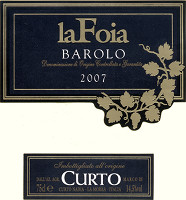
|
|
Barolo La Foia 2007 |
|
| Curto Marco (Piedmont, Italy) | |
| Grapes: Nebbiolo | |
| Price: € 30.00 | Score: |
| Barolo La Foia shows a brilliant ruby red color and nuances of garnet red, moderate transparency. The nose denotes intense, clean, pleasing and refined aromas that start with hints of cherry, plum and dried violet followed by aromas of raspberry, rose, tobacco, vanilla, chocolate, cinnamon and menthol. The mouth has good correspondence to the nose, a tannic attack and however balanced by alcohol, full body, intense flavors, pleasing crispness. The finish is persistent with flavors of cherry, plum and raspberry. Barolo La Foia ages for 4 years of which 2 in cask. | |
| Food Match: Game, Roasted meat, Stewed and braised meat | |
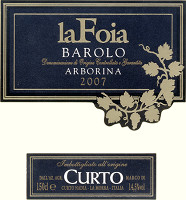
|
|
Barolo Arborina La Foia 2007 |
|
| Curto Marco (Piedmont, Italy) | |
| Grapes: Nebbiolo | |
| Price: € 30.00 | Score: |
| Barolo Arborina La Foia shows an intense ruby red color and nuances of garnet red, moderate transparency. The nose denotes intense, clean, pleasing, refined and elegant aromas which start with hints of plum, cherry and violet followed by aromas of raspberry, vanilla, blueberry, cinnamon, chocolate, tobacco, pink pepper, menthol and graphite. The mouth has good correspondence to the nose, a tannic attack and however balanced by alcohol, full body, intense flavors, pleasing crispness. The finish is persistent with flavors of cherry, plum and blueberry. Barolo Arborina La Foia ages for 4 years of which 2 in barrique. | |
| Food Match: Game, Roasted meat, Stewed and braised meat, Hard cheese | |
|
|
|
Malvasia delle Lipari 2008 |
|
| Florio (Sicily, Italy) | |
| Grapes: Malvasia delle Lipari, Corinto Nero | |
| Price: € 31.00 - 50cl | Score: |
| This Malvasia delle Lipari shows a brilliant amber yellow color and nuances of amber yellow, transparent. The nose reveals intense, clean, pleasing, refined and elegant aromas which start with hints of raisin, dried fig and dried apricot followed by aromas of candied fruits, peach jam, quince jam, vanilla, caper, lavender, almond, date, citrus fruit peel, honey and nail polish. The mouth has excellent correspondence to the nose, a sweet attack and however balanced by alcohol, good body, intense flavors, pleasing roundness. The finish is very persistent with long flavors of raisin, dried fig and dried apricot. This Malvasia delle Lipari ages for 5 months in barrique followed by at least 3 months of aging in bottle. | |
| Food Match: Confectionery, Dried fruit tarts, Hard and piquant cheese | |
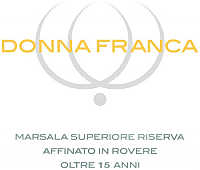
|
|
Marsala Superiore Riserva Semisecco Ambra Donna Franca |
|
| Florio (Sicily, Italy) | |
| Grapes: Grillo | |
| Price: € 25.00 - 50cl | Score: |
| Marsala Superiore Riserva Semisecco Ambra Donna Franca shows a deep amber yellow color and nuances of amber yellow, moderate transparency. The nose reveals intense, clean, pleasing, refined and elegant aromas which start with hints of dried fig, raisin, almond and dried apricot followed by aromas of date, caramel, honey, vanilla, citrus fruit peel, walnut husk, rancho and nail polish. The mouth has good correspondence to the nose, a sweet and round attack, however balanced by alcohol, full body, intense flavors, pleasing crispness. The finish is very persistent with with long flavors of dried fig, almond, raisin and dried apricot. Marsala Superiore Riserva Semisecco Ambra Donna Franca is produced with a selection of Marsala wines aged in cask from 15 to 30 years. | |
| Food Match: Dried fruit tarts, Hard and piquant cheese | |
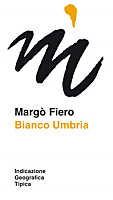
|
|
Fiero Bianco 2010 |
|
| Cantina Margò (Umbria, Italy) | |
| Grapes: Grechetto | |
| Price: € 14.00 | Score: |
| Fiero Bianco shows an intense straw yellow color and nuances of straw yellow, very transparent. The nose reveals intense, clean, pleasing and refined aromas that start with hints of apple, plum and hazelnut followed by aromas of pear, ripe peach, hawthorn, citrus fruits, broom and almond. The mouth has good correspondence to the nose, a crisp attack and however balanced by alcohol, good body, intense flavors, pleasing roundness. The finish is persistent with flavors of apple, plum and hazelnut. Fiero Bianco ages in steel tanks. | |
| Food Match: Stuffed pasta, Roasted white meat, Roasted fish | |
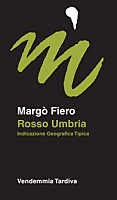
|
|
Fiero Rosso Vendemmia Tardiva 2009 |
|
| Cantina Margò (Umbria, Italy) | |
| Grapes: Sangiovese | |
| Price: € 25.00 - 375ml | Score: |
| Fiero Rosso Vendemmia Tardiva shows a brilliant ruby red color and nuances of brick red, moderate transparency. The nose denotes intense, clean, pleasing and refined aromas that start with hints of blackberry, plum and black cherry followed by aromas of strawberry, raspberry, blueberry, pink pepper, dried violet, dried rose and cinnamon. The mouth has good correspondence to the nose, a sweet and properly tannic attack and however balanced by alcohol, good body, intense flavors, pleasing crispness. The finish is persistent with flavors of blackberry, black cherry and plum. Fiero Rosso Vendemmia Tardiva is produced with late harvested grapes and part of grapes dried in mats. | |
| Food Match: Fruit tarts | |
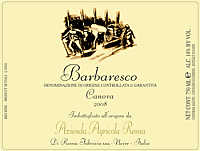
|
|
Barbaresco Canova 2008 |
|
| Ressia (Piemdont, Italy) | |
| Grapes: Nebbiolo | |
| Price: € 28.50 | Score: |
| Barbaresco Canova shows an intense ruby red color and nuances of garnet red, moderate transparency. The nose reveals intense, clean, pleasing, refined and elegant aromas that start with hints of plum, cherry and violet followed by aromas of raspberry, blueberry, vanilla, tobacco, mace, cocoa, cinnamon, dried rose and menthol. The mouth has good correspondence to the nose, a tannic attack and however balanced by alcohol, full body, intense flavors, pleasing roundness. The finish is persistent with flavors of cherry, plum and raspberry. Barbaresco Canova ages for 26 months in cask followed by 6 months of aging in bottle. | |
| Food Match: Game, Roasted meat, Braised and stewed meat, Hard cheese | |
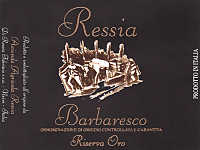
|
|
Barbaresco Riserva Oro 2005 |
|
| Ressia (Piedmont, Italy) | |
| Grapes: Nebbiolo | |
| Price: € 34.00 | Score: |
| Barbaresco Riserva Oro shows a brilliant ruby red color and nuances of garnet red, moderate transparency. The nose reveals intense, clean, pleasing, refined and elegant aromas that start with hints of plum, cherry and blueberry, followed by aromas of dried violet, raspberry, vanilla, cinnamon, mace, cocoa, tobacco, rose, leather and menthol. The mouth has excellent correspondence to the nose, a tannic attack and however balanced by alcohol, full body, intense flavors, pleasing roundness. The finish is very persistent with long flavors of plum, cherry and blueberry. Barbaresco Riserva Oro ages for 5 years in cask. | |
| Food Match: Game, Stewed and braised meat, Roasted meat, Hard cheese | |
News |
|
In this section are published news and information about events concerning the world of wine and food. Whoever is interested in publishing this kind of information can send us a mail to our address.
|
AquavitaeReview of Grappa, Distillates and Brandy |
|
|
| Distillates are rated according to DiWineTaste's evaluation method. Please see score legend in the "Wines of the Month" section. |

|
|
Grappa Cuore Gran Riserva |
|
| Nannoni (Tuscany, Italy) | |
| Raw matter: Pomace of grapes from Maremma | |
| Price: € 59.00 - 500ml | Score: |
| This grappa is limpid and crystalline, with a brilliant amber yellow color. The nose reveals intense, clean, pleasing, refined and elegant aromas of prune, honey, vanilla, chocolate, hazelnut, dried fig, black cherry and licorice, with almost imperceptible alcohol pungency. In the mouth has intense flavors with perceptible alcohol pungency which tends to dissolve rapidly, good correspondence to the nose, pleasing roundness, balanced sweetness. The finish is persistent with flavors of prune, honey, chocolate and hazelnut. This grappa is distilled in a batch steam operated alembic still and ages for 36 months in French oak casks. Alcohol 42%. | |
Wine Parade |
|
|
| The best 15 wines according to DiWineTaste's readers. To express your best three wines send us an E-mail or fill in the form available at our WEB site. |
| Rank | Wine, Producer | |
|---|---|---|
| 1 |
| Brunello di Montalcino 2006, Siro Pacenti (Italy) |
| 2 |
| Batàr 2008, Querciabella (Italy) |
| 3 |
| Barolo Cannubi Boschis 2005, Sandrone (Italy) |
| 4 |
| Collio Sauvignon Ronco delle Mele 2010, Venica (Italy) |
| 5 |
| Brunello di Montalcino Vigneto Manachiara 2005, Tenute Silvio Nardi (Italy) |
| 6 |
| Gran Masetto 2007, Endrizzi (Italy) |
| 7 |
| Rosso Conero Riserva Grosso Agontano 2007, Garofoli (Italy) |
| 8 |
| Arkezia Muffo di San Sisto 2004, Fazi Battaglia (Italy) |
| 9 |
| Adarmando 2009, Tabarrini (Italy) |
| 10 |
| Franciacorta Pas Dosé Récemment Dégorgé 2006, Cavalleri (Italy) |
| 11 |
| Sagrantino di Montefalco Collepiano 2007, Arnaldo Caprai (Italy) |
| 12 |
| Confini 2007, Lis Neris (Italy) |
| 13 |
| Avvoltore 2009, Moris Farms (Italy) |
| 14 |
| Trento Brut Riserva Methius 2004, Dorigati (Italy) |
| 15 |
| Aglianico del Vulture Il Repertorio 2006, Cantine del Notaio (Italy) |
| |||||||
Privacy Policy | |||||||


| Copyright © 2002-2024 Antonello Biancalana, DiWineTaste - All rights reserved |
| All rights reserved under international copyright conventions. No part of this publication and of this WEB site may be
reproduced or utilized in any form or by any means, electronic or mechanical, without permission in writing from DiWineTaste. |